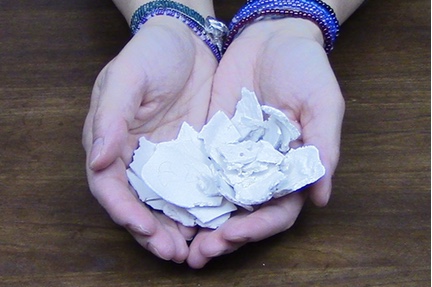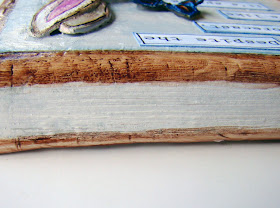Spring is on the way! The fae will be on the lookout for new garden homes, so now is the time to work on yours. I was going to show you how to use clay and natural materials on a cardboard house form, but my youngest daughter, Jessica, came up with the idea of using some broken pottery! Thanks, J!
You can craft this house from an old (or new) broken pot or ceramic vase.
For this project you will need:
a broken pot
Creative Paperclay® modeling material
glue water & sculpting tools
natural materials
Paverpol textile hardener
acrylic paints, paintbrushes, and a brush for applying Paverpol (large and med. soft bristles for getting the hardener into all the nooks and crannies of the piece - It will get sticky while you are using it, but can be cleaned with soap and water if the medium is not allowed to dry in the brush)
plastic wrap
plastic grocery bags or similar for creating form. You can use paper and cover it with plastic wrap also
optional but suggested - UV varnish - I'm using Josefine "very matte" also from the Paverpol company
sculpting tools - a craft stick and old paintbrush will work just fine
Gather up the pieces of your pottery and start re-assembling it, leaving openings for doors and windows as you see fit. Glue the pieces together and tape in place until the glue is dry. Try not to get glue on the front of the pot, as this might affect the paint layers later on.
When you've assembled the pot to your liking, play around with the natural materials you've gathered and see what you'd like to add. I will be adding some lovely sticks and stones with clay, then adding some additional decorations by gluing them on with Paverpol.
Wet the edges of the pottery and apply the clay, then embed natural materials as desired. Use a stiff paint brush or sculpting tool to get the clay in the cracks and crevices.
To add a door, place a piece of tracing paper over the pot and trace the edges of the opening. Cut a piece of cardboard to roughly this size, trim and fit as necessary, then place it in the pot with additional clay. You may need to do this a little bit at a time, depending on how large the door opening is. If necessary, allow the clay supports to dry before covering the rest of the cardboard with clay.
as you can see, I've broken off one of the branches in front of the door. I may glue it back on later, it depends on how I think the house looks at that stage.
Sculpt the door as you see fit. I always like to add stairs to my fairy houses so that I can nestle them into the dirt a bit without dirt getting in the front door!
Now I've done some sculpting on the other side of the pot, and it looks like a complete mess. No worries, I can clean the clay off. I'll be adding more natural materials and details to this window when I apply the Paverpol.
Create the windows by painting a layer of Paverpol all around the inside of the pot and applying a piece of plastic wrap to cover the window completely. Then paint Paverpol over the wrap. It will get bubbles, etc. I like the look of this frosted type window, because it doesn't allow the sun to shine all the way through the piece, and creates a nice effect if I put a tea light in the house later. You will need to apply several layers on the inside and outside to create a hardened "glass" window. Allow each coat of Paverpol to dry before applying the next.
When you've finished sculpting and have at least a layer of Paverpol on the windows, create a cap for the pot by bunching and taping plastic bags to the shape you desire. Remember that the clay over top of this will sit lower when the piece is finished, so keep that in mind when shaping your form. Cover the top with one single piece of plastic so you can remove the clay top from the form later.
(I really wanted to use that dried artichoke over the door, but now I can see that there won't be enough room if I make the top like I planned - oh well, I'll save it for another project!)
Roll or press out clay to about an 1/8"and apply to the roof form. If desired, press natural materials into the wet clay. I've used dried leaves, which I soaked in water until they became pliable, then put on the clay while they were wet so they would take the shape of the clay. I also sculpted the clay around the dried pumpkin stem so that it would look like the stem was part of the roof.
 |
I ended up adding another layer of plastic bags to support the edge of the roof since
I wanted it to stick out further and have a slight tilt upward to the edges |
Allow all of the clay to dry, then paint as desired.
Here is my painted piece drying in the sun.
When everything is dry, coat the entire piece with Paverpol. This medium is sticky, so you can also add more branches, tendrils, etc. by coating them and holding in place for a few seconds. Paint the bottom of the roof section and, when that is dry, glue it to the pot with Paverpol also. You will need to brush the medium on gently around the fragile leaves, etc., and it will appear lumpy, but have patience, it does a pretty good job of "self leveling" and not showing all the brush marks. When all of the Paverpol is dry, apply a UV varnish for further protection, if desired. When the varnish is dry, the house is ready to be placed in the garden! Look for the fairy footprints, and you'll know where to place their new home.
I haven't quite decided yet, there are footprints all over the place here. Here are some pics of the finished house.
 |
| I love the way the leaves turned out on this roof! I plan on using this technique again! |
 |
| The back window |
 |
| Possible placement? It looks pretty cozy here. |
Thanks for joining me here again!
I'd love for you to join me for more projects & art adventures on my
personal blog






























































